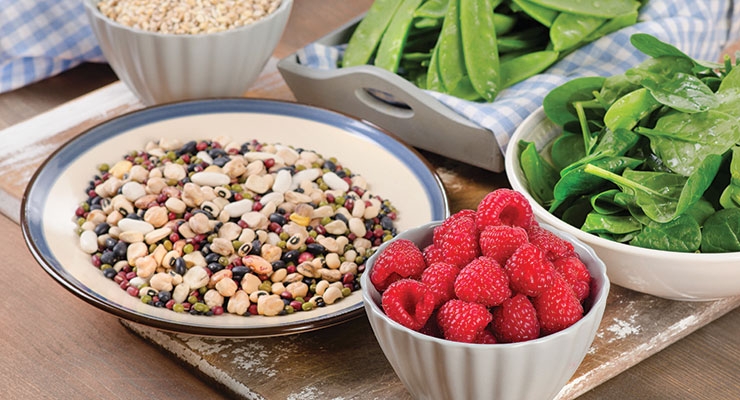Features
Functional Fiber: Key Contributions to Health & Wellness
The market for fortified foods, beverages and dietary supplements continues to expand to fill the fiber gap.

By: Sean Moloughney

The global dietary fibers market is projected to reach $4.31 billion in value by 2020, expanding at a CAGR of around 13.2%, according to a 2015 report from Markets and Markets.
Driven by public health concerns, consumers’ increasing attention to their diet and innovative formulation practices, alongside refined ingredient offerings, the global market has been primed for full-scale expansion. The functional foods sector is the biggest segment by application, according to Markets and Markets, and major players are responding to new opportunities by broadening their worldwide presence and expanding product lines.
“The global dietary fiber market is witnessing tremendous growth due to the increasing demand for healthy and natural food products from health-conscious consumers,” said David Daguet, scientific manager at France-based Nexira.
Fibers offer notable health benefits and address a wide spectrum of concerns, he added. Scientific studies continue to highlight their nutritional importance and their health benefits are becoming more specific, targeting digestive comfort, intestinal transit, feelings of satiety/weight control, improvement of intestinal flora, well-being from within, blood sugar regulation and more.
“Today, research goes further and highlights that dietary fibers could be involved in reducing the risk of inflammatory diseases like obesity, diabetes and cardiovascular disease,” said Mr. Daguet. “But beyond their health benefits, dietary fibers must offer technological advantages, allowing companies to overcome formulation challenges in terms of taste, texture, stability and shelf-life, and digestive comfort.”
Consumers are increasingly aware of the beneficial effect of fibers, according to Jon Peters, president, BENEO, Inc. Morris Plains, NJ. In fact, in 2015, U.S. consumer research commissioned by BENEO and conducted by HealthFocus International confirmed the importance consumers place on fiber intake.
“The research results indicate a high level of consumer awareness of fiber being an important ingredient for a healthy and balanced diet,” said Mr. Peters. “An overwhelming 93% of consumers responded that fiber is good for their overall health. Consumers are also aware that fibers contribute to a healthy gut and weight management, with 91% responding that fiber is beneficial for their intestinal health and 68% saying fiber helps them feel fuller longer. Additionally, 63% maintain that fiber helps them eat less during the day.”
However, the majority of U.S. consumers have difficulties reaching the recommended daily intake of fiber, which is about 25 grams per day. “This is why fortified products that can be easily integrated into the daily diet are increasingly in demand,” he added. “With high protein products becoming more and more relevant, the combination of fiber and protein is a perfect match to meet current consumer requests for a healthier diet and lifestyle.”
According to New Nutrition Business, digestive health is a common driver behind many of the key trends currently taking place in the health and wellness market, including “free-from” and “naturally functional” products.
“Also, due to the convergence of a series of lifestyle and market trends, digestive health has moved from being a medically-driven topic to a wellness-driven consideration in a growing number of consumers’ minds,” noted Mr. Peters.
Mintel’s Global New Product Database showed that between 2013 and 2015, 16% of functional claims globally related to digestive health, making it one of the most important functional claims. Data from Euromonitor showed the digestive health market was worth $70 billion globally in 2015.
Santiago Vega, senior manager of nutrition marketing, Ingredion Incorporated, Westchester, IL, noted that an aging population has been driving growth in the fiber market due to increasing health concerns and awareness of the benefits of fiber.
“According to research from HealthFocus International in 2015, 79% of consumers said they are interested in fiber and 36% of them report that ‘high fiber’ is an extremely or very important product claim. Along the same lines, 82% in the HealthFocus study said they would be interested in buying products that help them with weight management.”
Despite growing interest in fiber, proprietary research from Ingredion in 2015 indicated that 45% of consumers reported having difficulty finding nutrition bars that are high in fiber, said Mr. Vega. “A large opportunity exists for products that have fiber and promote digestive health, blood sugar management or many of the other health benefits of fibers.”
Fiber Basics
While most people commonly connect fiber with digestive regularity, it may also help to maintain a healthy weight and lower the risk of heart disease and diabetes.
Fibers can be classified generally into two major categories: soluble and insoluble, noted Jit Ang, executive vice president of the fiber division within Solvaira Specialties, North Tonawanda, NY (formerly International Fiber Corporation). Soluble fibers are soluble in water while insoluble fibers are not. “Examples of soluble fibers include gums, pectin and beta-glucans. Insoluble fibers include cellulose, wheat fiber, cottonseed fiber, bamboo fiber, oat hull fiber and soy hull fiber. Most insoluble fibers are cellulosic in nature since cellulose is the most abundant source of insoluble fiber in the world. It is the principal structural component of all plants. Soluble fibers, on the other hand, are made up of a wide variety of chemical compounds including pectic acids, some hemicelluloses, gums and mucilages.”
Fiber is beneficial for many reasons, he continued. “While soluble fibers have been linked to health benefits related to gastrointestinal functions (e.g., cholesterol reduction), insoluble fibers can provide improved bowel functions. In addition, most fibers are also positively correlated to improved glycemic index responses. Foods containing fiber are typically healthier and also lower in calories since insoluble fibers are non-caloric while soluble fibers are only partially caloric. Therefore, consuming these foods would also fit into most dietary plans, from weight loss diets to weight maintenance diets.”
Prebiotic properties of some fibers promote gastrointestinal health, noted Heiko Zipp, director of the business team for Wacker Biosolutions (Germany). Additionally, they are also said to lower cholesterol levels and to reduce the risk of coronary heart disease.
In terms of daily fiber intake, men age 50 or younger should be getting 38 grams, while women 50 and younger should strive for 25 grams; men over 50 should strive for 30 grams and women over 50 need about 21 grams, according to the Institute of Medicine.
Ingredion’s Mr. Vega noted that while fibers are most commonly categorized by their degree of solubility, there are many other characteristics that define fibers, such as degree of fermentability, which also imparts specific health benefits.
“Insoluble, intrinsic fibers that are not fermentable, such as those found in the pericarps of many grains, generally contribute to bulking of the stools and promote laxation and regularity. Insoluble fibers that are fermented, such as resistant starch, have been shown to provide benefits for blood glucose management, weight management and digestive health,” he said.
Ingredion manufactures resistant starch under the brand name HI-MAIZE, derived from high amylose corn. Resistant starches have been defined as starches that resist digestion within the small intestine and ferment in the colon. They help support a healthy weight, maintain healthy blood sugar levels as part of a high fiber diet, promote energy balance, increase satiety, and can be a good and excellent source of fiber, Mr. Vega added.
“On the soluble fibers group, those with high water-holding capacity, which include hydrocolloids, can contribute to satiety and stool bulking, therefore supporting weight management and digestive health. Oat fiber has been widely studied for its effects on reducing cholesterol. Oligosaccharides, such as fructooligosaccharides (FOS) or galactooligosaccharides (GOS), which are soluble and don’t contribute to bulking, have strong evidence demonstrating their effects of promoting the growth of beneficial bacteria and, in certain cases, helping reduce populations of pathogens, therefore supporting digestive and immune health.” The company manufactures short chain FOS under the brand name NutraFlora prebiotic fiber, and GOS under the brand name BIOLIGO GOS.
The choice of fiber for the product developer will depend on the types of claims intended and the delivery format or type of formulation of the product, since the functionality and effective dose of the fiber will largely determine its applicability, Mr. Vega noted.
Diversity of Health Benefits
There has been a shift in the way consumers view fiber, according to Carol Lowry, senior food scientist, Cargill, Minneapolis, MN. “It’s not just a tool for regularity and bulking. Increasingly, consumers understand that the fiber moving through the body can interact with other beneficial bacteria and benefit their overall health outcome.”
“Much like advances in DNA analysis made it possible and affordable for consumers to sequence their own genome,” she continued, “we are beginning to see similar kits available for personal microbiome mapping. As these at-home microbiome analysis kits become more accessible, consumers will have a greater awareness of the link between microbiome health and their overall health. The more this is understood, the greater the emphasis consumers will place on incorporating prebiotic fibers into their diets.”
Deeper understanding of the microbiome and its role in supporting overall human health continues to emerge, according to Ingredion’s Mr. Vega. “While more studies need to be completed to establish direct cause and effect, it is now believed that microbiome health can influence diverse health areas ranging from brain health to weight management to immune response.”
Patrick Luchsinger, nutrition marketing manager at Ingredion also noted that the intestinal microbiome has been a significant topic of interest in recent years, and research is ongoing. “What we do know is that the gut microbiome consists of at least 1,000 different species of known bacteria and other microscopic life forms. One third of the microorganisms living in your particular gut microbiome are also found in most other people’s gut microbiomes, but two thirds of the microorganisms in your gut are specific just to you.”
It is increasingly understood that fibers play a critical role in helping establish and maintain a healthy microbiome, Mr. Vega said.
“Research based on analysis of stools from our ancestors’ points to the fact that they had a much more diverse microbiome than humans do today, and much of that healthy diversity was due to much higher consumption of fiber from many sources. Therefore, new research suggests that regular consumption of soluble, highly fermentable fibers and insoluble fermentable fibers is important for promoting a healthy microbiome. The role of fiber is to provide the food, or media, for the beneficial bacteria to establish and colonize the large intestine, and by doing so, ‘crowding out’ or inhibiting the growth of pathogens.”
Recent research has shown that different fibers have varying effects on the composition of the microbiota. “For instance, new evidence is emerging on the role of type 2 resistant starch in generating shifts in phyla in humans with metabolic syndrome,” said Mr. Vega.
Overall, understanding of the role fibers play in promoting health has increased significantly in the last 10 years, he added. “For instance, there is a growing number of clinical studies showing the positive effects of fiber fermentation in the colon in supporting digestive and immune health, and how fibers like short chain FOS are utilized more selectively and effectively by Bifidobacterium and other beneficial bacteria in the large intestine.”
Beneo’s Mr. Peters also acknowledged that the relationship between the intestinal microflora and health is receiving more attention among researchers. “Data suggest that the composition of the colonic microflora has important implications for our body function and health,” he said. “A healthy local microflora supports our gut barrier function and prevents our body from pathogenic microorganisms. Our defense and immune system, which is also very active in the intestines, depends on bugs that do not even form part of our body.”
To date, there are more than 150 human intervention studies on BENEO’s chicory root fibers inulin and oligofructose, Mr. Peters said. “These studies deliver strong evidence for distinct health benefits, including digestive health (prebiotic effect, bowel function), weight management (eating less, naturally), blood glucose management and bone health (calcium absorption).”
Inulin and oligofructose are not digested in the stomach or small intestine but are completely fermented in the large intestine. Fermentation is key to some of the beneficial effects of chicory root fibers in the colon, according to Mr. Peters. “Short chain fatty acids (SCFAs) are formed by the prebiotic fermentation through beneficial colon microbiota. BENEO’s chicory root fibers inulin and oligofructose stimulate the growth of these beneficial bacteria at the expense of less beneficial or even pathogenic bacteria. They help to shape a more balanced gut microflora that contributes to our health.”
SCFAs are also known to have a stimulating effect on bowel movements. Non-fermentable fibers (such as whole grains) are merely effective for stool bulking, (i.e., passing through the body unaltered), he said. “Prebiotic fermentation of chicory root fibers stimulates bowel movements in a mild and natural manner by slightly increasing the number of bowel movements per week. Early in 2016 the European Commission authorized an exclusive health claim for BENEO’s prebiotic fiber inulin supporting regular bowel function. The authorization was based on six human intervention studies that consistently proved that consumption of inulin increases stool frequency without triggering diarrhea, due to inulin resisting digestion in the small intestine, while being fully fermented in the large intestine. In the U.S., customers can use structure-function claims on digestive health including bowel regularity.”
With global growth of bowel pathologies such as irritable bowel syndrome (IBS) and inflammatory bowel disease (IBD), overall interest in gut health has grown in general, but specifically in relation to the intestinal barrier, according to Nexira’s Mr. Daguet. “The gut barrier is one of the most important components of the innate immune system. Its main role is to absorb nutrients and to serve as one of our body’s most important barriers.”
Nexira’s Fibregum, an all-natural, soluble fiber sourced from acacia gum trees, is non-GMO, clean label and offers a guaranteed minimum 90% soluble dietary fiber, according to the company.
Based on preliminary results on digestive health, with a prebiotic effect and the production of beneficial short chain fatty acids, Nexira recently conducted an ambitious experiment that demonstrated the innovative physiological properties of Fibregum on gut permeability and microbiota using the Simulator of the Human Intestinal Microbial Ecosystem (SHIME).
According to Mr. Daguet, the SHIME is a device that has been used for experiments to mimic the entire gastrointestinal tract, including the stomach, small intestine and the three regions of the large intestine (ascending, transverse and descending). “These experiments showed that Fibregum fermentation in the distal part of the colon can modulate the composition of the gut microbiota and induce the production of beneficial SCFA. Moreover, Fibregum showed an anti-inflammatory effect and an improvement of the gut permeability. As a result, all the positive effects of Fibregum observed both on the reduction of inflammatory status and on the improvement of gut permeability contribute to increase the gut barrier.”
Product Development
Nutrition bars stand out as a category where product developers have embraced fiber and the associated health benefits, according to Karri Santamaria, product manager for specialty carbohydrates at Cargill. “Today, we have a bar for every need, every occasion, every person, every age and every part of the day. Many of those bars feature chicory root fiber, which easily incorporates into bars—whatever their flavor or texture.”
Functional beverages also continue to gain widespread popularity, with a steady stream of new products entering the marketplace. “Much like we’ve seen with bars, chicory root fiber plays prominently in many of these new functional beverage products, providing the fiber and digestive health benefits that consumers are increasingly seeking.”
To meet fiber inclusion targets in bakery items, whole grains can only contribute so much, said Ms. Santamaria. Chicory root fiber like the company’s Oliggo-Fiber can help fill the gap without impacting taste or texture. Cargill’s Ms. Lowry said chicory root fiber also aligns with clean label trends. “Across the food and beverage industry, there’s a big push to simplify ingredient lists. Today’s consumers want to recognize the ingredients in their food and beverages and know where those ingredients come from. Oliggo-Fiber, which may appear on ingredient statements as chicory root fiber, offers a label-friendly, non-GMO option to promote digestive health.”
On average, consumers are only getting about half the amount of fiber they need, said Beneo’s Mr. Peters. “It’s evident that the so-called fiber gap needs to be closed, but even with balanced nutrition it is hard to achieve the set goal of 25 grams/day. Fiber-fortified products and supplements can be easily integrated into the daily diet and thus are gaining more and more interest and acceptance.
Fiber combinations are proving to be useful as food technologists are looking for new tools to achieve varying objectives in the food industry, according to Solvaira Specialties’ Mr. Ang. “Not only can these combinations bring important nutritional improvement—such as caloric and fat reduction—but some of these new approaches can also provide unique textural properties. A newly developed blend from International Fiber Corporation comprising of partially soluble and insoluble fibers has been successfully incorporated into sausage-style meat toppings for use in pizzas. This fiber blend was instrumental in providing a healthier meat topping that also rendered the product juicier and more tolerant to cooking. The meat topping containing this fiber blend did not shrink or toughen after baking.”
Ultimately, when incorporating fiber into formulas, companies aim to create health products that also taste great and can appeal to consumers, said Wacker’s Mr. Zipp. “So in my view, the most important innovation in recent years was to successfully incorporate fiber into food products without any impact on the taste. Beyond that, I think a product’s attraction is even bigger if a health claim can be used.”
He also pointed to two different approaches to product development. “On the one hand, it’s about minimizing or even eliminating negative impacts with the help of fibers. On the other hand, the food and dietary supplement industry tries to make use of the positive impacts given to a product by fibers, which is, of course, a crucial point for supplements.”
For product developers, the type of fiber plays an important role, because the product must deliver health benefits and also meet consumer expectations on taste, said Mr. Zipp. “Therefore, the best fiber, from a manufacturer’s point of view, has no taste or color impact on the end product, and does either not influence the product properties at all, or even offers beneficial effects on the mouth feel and consistency. Another important point is the solubility of the fiber, as this property can be crucial for product development.”
Innovation & Future Directions
The fiber market is continually innovating, according to Beneo’s Mr. Peters. “We see a lot of new food and beverage products with more balanced nutritional profiles. Consumer demands for high fiber, high protein and less sugar are driving these developments. thinkThin, for example, has recently launched a line of Protein and Fiber Hot Oatmeal products containing chicory root fiber that contain less than 200 calories while delivering 10 grams of protein and 5 grams of fiber per serving. This line of hot oatmeal cereals are a great example of products that are delivering the nutrition that consumers are looking for—high in protein and fiber—in a balanced and calorie-controlled way.”
Over the past few years, innovations in fiber ingredients and formulation technologies have vastly broadened the scope of finished fiber products, according to Ingredion’s Mr. Vega. Moving from traditional low-moisture product categories like breads and cereals, companies are now including fiber in “previously uncharted categories,” such as dietary supplements, functional beverages, bars and snacks, dairy products and more.
“Leading-edge ingredient technology enabled the development of smaller molecular weight fibers and fibers with enhanced solubility and process versatility,” he said. “This in turn is rendering some soluble fibers to be essentially ‘invisible’ in food or supplement systems, facilitating their use with barely any discernible impact on product quality.”
Healthy snacking in general has been one of the largest trends related to fiber fortification and innovation, said Mr. Luchsinger. “It’s not just breakfast, lunch and dinner anymore. There is now midday breakfast, commute snack, power snack and many more.
Growing numbers of Americans snack four or five times day. Consumers are very willing to buy new and innovative healthy snacks. And they seek healthy quick foods to replace traditional meal occasions. Therefore, healthier options are being positioned as snacks, including yogurts, shakes, oatmeal and nuts, all of which dietary or prebiotic fiber can be included into.”
Many of the innovations in product development of late are focused on the combination of prebiotic fibers with probiotic strains, Mr. Vega added. “Food, beverage and supplement companies are capitalizing on the growing understanding of the synergy between prebiotics and probiotics to promote a healthy gut microbiota, and increased consumer awareness of this synergy, to launch innovative functional foods and beverages.”
Additionally, given the rise of obesity and type 2 diabetes, companies are increasingly positioning their products around blood sugar management. “A category that used to be dominated by one or two large players is seeing many companies emerge with products in different formats, from bars to snacks to shakes, focusing on helping consumers manage blood sugar and/or manage diabetes,” said Mr. Vega. “The role that fibers such as resistant starch play in supporting healthy blood sugar levels and promoting a healthy weight is increasingly understood by consumers and they are looking at more products that can deliver these benefits.”
Ultimately, according to Mr. Luchsinger, “better-for-you foods come and go, but the health halo and research around fiber and fiber-rich foods has been more firmly affixed than other foods/ingredients perceived as key to a healthy diet.”
However, Solvaira’s Mr. Ang noted that the new FDA proposal on the definition and labeling of fiber in foods is an important issue for companies to understand. “When implemented, the consequences of this new law will be greatly felt by the food industry as well as by consumers. Among many issues addressed, the new law may change the current fiber definition, how we label fiber, how fibers are tracked and calculated for nutritional information, the recommended daily intake for fibers, and also what sources of fiber can be legally claimed as such.” Consequently, the law may exclude some sources of dietary fiber currently used by the food industry, he added.




















